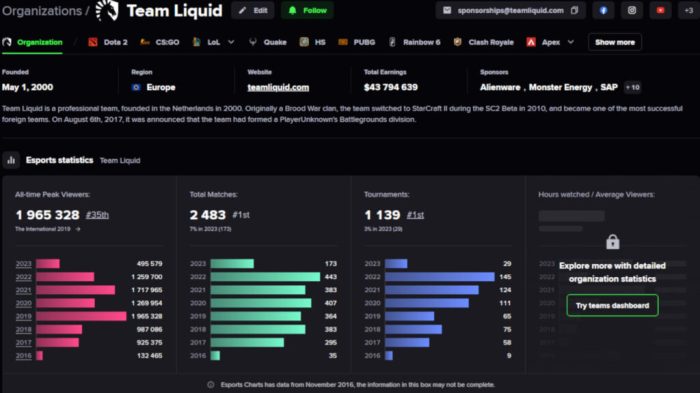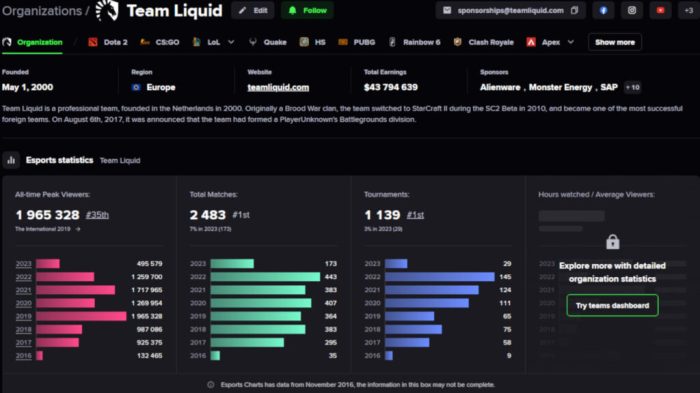Esports performance tracking is way more than just crunching numbers; it’s about unlocking the secrets to victory. Think of it as the advanced scouting report, but on steroids. We’re talking about analyzing everything from reaction times to strategic decision-making, using data to gain a competitive edge. This deep dive explores how teams leverage data to improve player performance, refine strategies, and ultimately, dominate the competition.
From understanding the core components of a robust tracking system to mastering data analysis techniques, we’ll cover the entire spectrum. We’ll also look at the different technologies used, the ethical considerations, and the exciting future of this rapidly evolving field. Get ready to level up your understanding of esports analytics!
Data Analysis and Interpretation: Esports Performance Tracking
![]()
Okay, so we’ve got all this sweet esports data – now what? We need to wrangle it into something useful, something that tells us who’s crushing it and why. This section dives into the nitty-gritty of data analysis for esports performance, from cleaning up the mess to visualizing killer insights.Data cleaning and preparation is the unsung hero of any successful esports analysis.
Think of it as prepping your ingredients before you start cooking – you wouldn’t throw raw chicken straight into the oven, right? Similarly, raw data is often messy, inconsistent, and full of errors. We need to clean it up before we can get meaningful results.
Data Cleaning and Preparation Methods
This involves several key steps. First, we handle missing values. This could mean removing rows with missing data, imputing values (filling in missing data based on other data points), or using statistical techniques to estimate missing values. Next, we address outliers – those extreme values that can skew our analysis. We might remove them, transform them, or investigate them further to understand why they exist.
Finally, data transformation might be needed to normalize or standardize data, making it easier to compare different variables or apply certain statistical techniques. For example, we might convert reaction times to z-scores to compare players across different games with varying base reaction times.
Statistical Techniques for Esports Data Analysis
Now for the fun part: crunching the numbers! Regression analysis is a go-to for understanding the relationship between variables. For instance, we could use linear regression to see how a player’s KDA (Kills, Deaths, Assists) correlates with their win rate. Time series analysis is another useful tool, especially for tracking player performance over time. This lets us identify trends, like a player’s improvement or decline in skill over a season.
We could use techniques like ARIMA (Autoregressive Integrated Moving Average) modeling to predict future performance based on past data.
Identifying Trends and Patterns
Once we’ve run our statistical analyses, the real work begins: finding the story in the data. This often involves exploring correlations between different variables, looking for significant changes over time, and identifying clusters of players with similar performance characteristics. For example, we might discover a strong correlation between average damage per minute and win rate in a specific game, or notice a sudden drop in a player’s accuracy after a change in their gaming setup.
Visual Representation of Esports Performance Data, Esports performance tracking
Finally, we need to present our findings in a way that’s clear, concise, and visually appealing. Charts and graphs are our best friends here. Line graphs are great for showing trends over time (e.g., a player’s KDA over a season). Scatter plots are useful for exploring relationships between two variables (e.g., KDA vs. win rate).
Bar charts are perfect for comparing different players or teams (e.g., average damage dealt by different players). Heatmaps can visually represent complex datasets, highlighting areas of strength or weakness (e.g., a player’s map awareness across different game maps). Pie charts can show the proportion of different outcomes (e.g., win/loss ratio). The key is to choose the chart type that best represents the data and the story you’re trying to tell.
For example, a poorly chosen chart can misrepresent the data and lead to inaccurate conclusions. Choosing the right visualization method is crucial for effective communication of results.
Technological Aspects of Performance Tracking

Esports performance tracking relies heavily on sophisticated technology to capture, analyze, and interpret vast amounts of data. The effectiveness of any performance analysis hinges on the quality and capabilities of the tools employed. This section dives into the hardware and software involved, comparing different platforms and outlining a potential system design, while also acknowledging the current limitations of the technology.
Software and Hardware Tools in Esports Performance Tracking
A robust esports performance tracking system necessitates a combination of hardware and software components working in concert. On the hardware side, high-speed cameras capable of capturing high frame-rate video are essential for precise movement tracking. These cameras often need to be strategically positioned to capture a complete view of the playing area. Powerful computers with substantial processing power and ample storage are crucial for handling the large datasets generated by these cameras.
Additionally, specialized sensors, such as motion capture suits or peripherals with embedded sensors, can provide supplementary data points for more comprehensive analysis. On the software side, dedicated performance tracking platforms are used to process the raw data from the hardware, employing advanced algorithms for data analysis and visualization. These platforms often incorporate machine learning techniques for automated event detection and pattern recognition.
Comparison of Performance Tracking Platforms
Several performance tracking platforms cater to the esports industry, each with its own strengths and weaknesses. For instance, some platforms might excel in capturing specific game metrics, such as reaction times or aiming accuracy, while others might focus on broader aspects like player movement and spatial awareness. A hypothetical comparison could be drawn between two fictional platforms: “ApexTrack,” which focuses on highly granular data capture and sophisticated statistical analysis, suitable for professional teams needing in-depth insights, and “GameSight,” a more user-friendly platform offering simpler visualizations and readily accessible performance metrics, ideal for amateur teams or individual players.
ApexTrack might utilize more advanced machine learning algorithms for automated event detection and offer customizable dashboards, while GameSight prioritizes ease of use and intuitive interfaces. The choice of platform depends heavily on the specific needs and resources of the team or organization.
Hypothetical Esports Performance Tracking System Design
A hypothetical esports performance tracking system could be designed with a modular architecture, allowing for flexibility and scalability. The system would begin with a network of high-speed cameras strategically positioned around the playing area, feeding data into a central server. This server would house the core processing unit, utilizing custom-built software to process the raw video data. The software would incorporate algorithms for player tracking, event detection (e.g., kills, deaths, objectives completed), and metric calculation (e.g., reaction time, accuracy, movement speed).
A user interface would allow coaches and analysts to access and visualize the data in various formats, including customizable dashboards, heatmaps, and statistical reports. The system could also integrate with other data sources, such as in-game APIs, to provide a holistic view of player performance. Furthermore, cloud storage and data management tools would be necessary for efficient data handling and archiving.
Challenges and Limitations of Current Esports Performance Tracking Technologies
Despite significant advancements, current esports performance tracking technologies still face several challenges. One major hurdle is the complexity of capturing and analyzing data from fast-paced games. The sheer volume of data generated necessitates significant processing power, potentially leading to delays in real-time analysis. Another challenge lies in accurately capturing and interpreting subtle movements and actions, especially in games with complex mechanics.
Occlusion, where players or objects obstruct the view of cameras, can also pose a significant problem, leading to data loss or inaccuracies. Finally, the cost of implementing a comprehensive performance tracking system can be prohibitive for many teams and organizations, particularly smaller ones. The development and maintenance of specialized software and hardware can be expensive, and requires skilled personnel to operate and maintain the system effectively.
FAQ Corner
What’s the difference between in-game APIs and third-party tools for data collection?
In-game APIs provide direct access to game data, often offering more granular information but requiring technical expertise. Third-party tools are user-friendly but might offer less detailed data or be limited by game compatibility.
How can performance tracking improve team communication?
By visualizing player performance and identifying areas for improvement, data can highlight communication breakdowns. For example, tracking communication frequency and success rates can show where players need more coordination.
Are there privacy concerns with esports performance tracking?
Yes, handling player data responsibly is crucial. Teams need clear policies on data collection, storage, and use, ensuring player consent and adherence to privacy regulations.
What are some ethical considerations related to using AI in esports performance tracking?
AI raises concerns about bias in algorithms, potential for unfair advantages, and the need for transparency in how AI-driven insights are used. Ensuring fairness and equal opportunity for all players is paramount.
